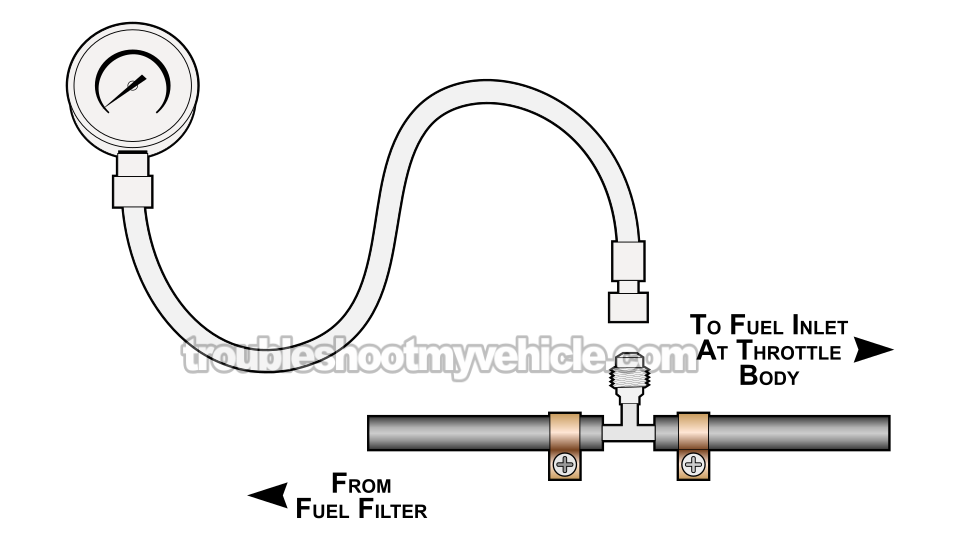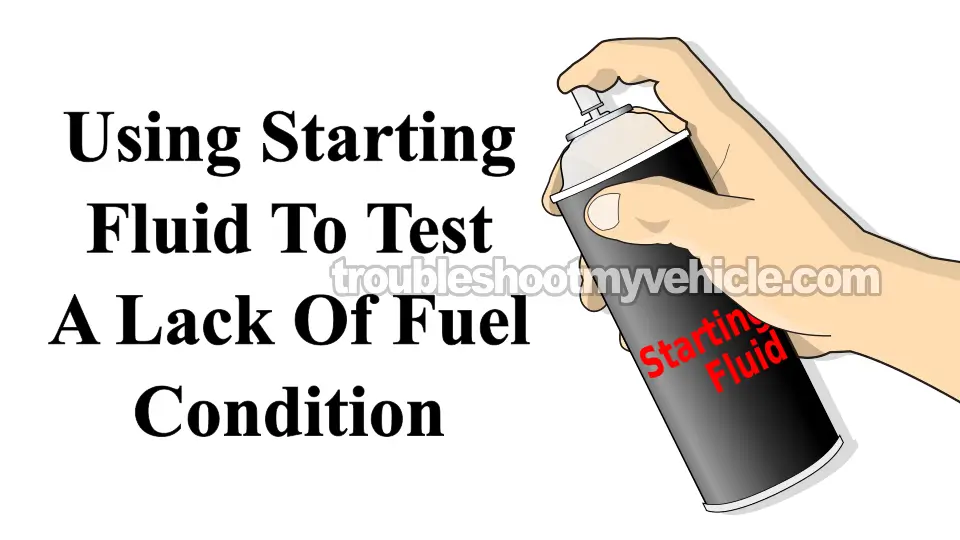
Checking whether the fuel pump on your 1989-1991 3.9L V6 Dodge Ram van is good or bad (with a fuel pressure test gauge) is a pretty easy thing to do.
In this tutorial, I'll walk you through the testing process step by step. With your test results, you'll be able to confirm whether your van's fuel pump is OK or not.
Also, I'm gonna show you how starting fluid can help you diagnose an engine no-start issue caused by a lack of fuel (like when the fuel pump is bad).
Contents of this tutorial:
APPLIES TO: This tutorial applies to the following Dodge Ram vans:
- 3.9L V6 Dodge Ram B150 Van: 1989, 1990, 1991.
- 3.9L V6 Dodge Ram B250 Van: 1989, 1990, 1991.
Fuel Pump Circuit Wiring Diagram:
- Fuel Pump Circuit Wiring Diagram (1989 3.9L V6 Dodge Ram Pickups).
- Fuel Pump Circuit Wiring Diagram (1990-1991 3.9L V6 Dodge Ram Van).
Symptoms Of A Bad Fuel Pump
Generally, fuel pumps tend to malfunction in one of two ways:
- Total Failure: The pump ceases functioning altogether and no more fuel to the injectors. Although the engine turns over, it won't start.
- Reduced Efficiency: The pump continues to operate but doesn't supply the correct amount of fuel. The engine may start but engine performance suffers, especially under load.
If the pump hasn't completely failed, you'll see one or more of the following symptoms:
- Rough idle: The engine runs rough when idling at a stop or traffic light.
- Hard starting: You've got to crank the engine a long time before it finally starts.
- Lack of power: This is especially evident when you stick the transmission in Drive and you accelerate.
- Backfires: These are the characteristic "popping" noises emanating from the intake manifold when you step on the gas pedal and the fuel pump's degraded performance is causing a lean air/fuel mixture.
- Running lean: An insufficient fuel supply wreaks havoc on the air/fuel ratio the engine needs to run optimally. This triggers oxygen sensor or "lean" diagnostic trouble codes.
If your van doesn't start or starts and runs badly, a fuel pressure test can help you determine if the issue lies with the fuel pump.
What is a "lean air/fuel mixture"? An engine operates at its best when it receives the correct ratio of air and fuel. The fuel injection system regulates the amount of fuel according to the engine's air intake. If the engine is not receiving sufficient fuel relative to the amount of air it draws in, as usually happens when the fuel pump is failing, the air/fuel mixture is said to be "lean".
If the system adds too much fuel for the air coming in, the mixture is considered "rich".
Fuel Pressure Specifications
| 1989-1991 | |
|---|---|
| 3.9L V6 | 14.5 PSI (Throttle Body Injection -TBI- System) |
Where To Buy A Fuel Pressure Test Gauge
One of the most essential tools a serious DIY mechanic should have in his or her toolbox is a fuel pressure test gauge. Fortunately, you can find them in any auto parts stores. If you don't already have one, here are my recommendations:
Disclosure: As an Amazon Associate, I earn from qualifying purchases. If my tutorials help you, using these links is an easy way to support the site at no extra cost to you. Thank you!
TEST 1: Checking Fuel Pressure With A Fuel Pressure Gauge

Two rubber fuel hoses are attached to your throttle body and secured using hose clamps. One is the fuel pressure inlet hose (5/16"), while the other is the return hose (1/4").
To check the fuel pump's pressure, we'll connect a fuel pressure test adapter between the 5/16" inlet hose and the metal inlet port of the throttle body (see the illustration above).
You'll notice that the inlet port is located at the bottom rear of the throttle body; this is where the 5/16" hose connects. The smaller hose connected to the top port is the 1/4" fuel return hose.
If you don't own a pressure test kit with the appropriate adapter, take a look at my recommendations here: Best Places To Buy A Fuel Pressure Test Gauge.
Alright, let's get this show on the road:
- 1
Remove the air filter cleaner assembly from the throttle body.
- 2
Disconnect the fuel pressure regulator from its vacuum hose.
- 3
Disable the ignition system. We need to make sure the engine cannot be started during the test.
NOTE: To disable the ignition system, simply disconnect one of the two wires from the ignition coil. Do not disconnect the distributor from its 3-wire connector. - 4
Disconnect the fuel injectors' connector.
IMPORTANT: The fuel injectors should not spray fuel during the fuel pressure test. - 5
Place a shop towel beneath the 5/16" fuel inlet hose.
The towel is there to catch any gasoline that might leak out in the next step. - 6
Disconnect the 5/16" fuel inlet hose from the throttle body's inlet port.
NOTE: You have two hoses —one is 5/16" and the other is 1/4". The larger one (5/16") is the inlet hose you need. - 7
Connect the adapter's hose to the inlet port, then connect the pressure gauge adapter to it.
- 8
Now attach the 5/16" inlet hose you removed earlier to the fuel pressure gauge adapter.
- 9
Once ready, have your helper turn the key on and off quickly several times.
Check the fuel pressure gauge adapter and hoses for leaks. If fuel is leaking, tighten those hose clamps until it stops. - 10
Have helper crank the engine and then let go of the key as you monitor the gauge.
NOTE: With the ignition coil and fuel injectors disabled, the engine won't start. But to activate the fuel pump and get a maximum pressure reading, the engine has to be cranked. - 11
The fuel pressure gauge should display 14.5 PSI.
Let's analyze what your test results:
CASE 1: The fuel pressure gauge displays 0 PSI. This indicates that the engine's failure to start is due to no fuel supply reaching the fuel injectors.
In approximately 99% of instances, this result confirms the fuel pump is bad and you need to replace it. In the remaining 1%, it's possible that the fuel pump isn't receiving power.
It's a good idea to verify that the fuel pump is receiving 10 to 12 Volts DC (while the engine is cranking) to confirm it has truly failed.
CASE 2: The gauge indicates lower pressure than specified. This result confirms the fuel pump is failing. It's time for a replacement.
CASE 3: The gauge reads the correct PSI. In this case, you can conclude that the fuel pump is operating as expected.
If your Dodge Ram van's engine fails to start, it's not due to a fuel pump issue. The pump is functioning correctly and supplying sufficient fuel to the injectors. You'll need to investigate further since another issue is preventing your van from starting.
TEST 2: Using Starting Fluid To Confirm Lack Of Fuel

To quickly determine if the engine won't start due to a "no-fuel issue", you can use starting fluid to see if it can get the engine started.
This test involves spraying starting fluid into the throttle body, followed by cranking the engine. You'll see one of two things:
- Engine starts: If there's insufficient fuel causing the engine not to start, the engine should start and run for a few seconds (until the starting fluid is consumed).
- Engine won't start: This confirms that a lack of fuel is not behind the engine no-start problem.
While this method isn't the most accurate way to test the fuel pump, it does serve as a good starting point when trying to diagnose an engine no-start.
IMPORTANT: To get an accurate test result, all six spark plug wires should be delivering spark to their spark plugs. If you haven't checked them for spark with a spark tester yet, please do so now.
CAUTION: This test is pretty straightforward, but there's one important safety measure to keep in mind: After spraying the starting fluid, place the air cleaner cover back on the air cleaner before cranking the engine.
You don't need to secure it with the clamp —just set it in place. This helps prevent any backfires from shooting flames out of the throttle body and onto the engine while cranking.
Let's get going:
- 1
Remove only the air cleaner assembly's top cover.
The air filter cleaner assembly itself should remain on the throttle body —just remove its top cover. - 2
Hold the throttle plate open and spray starting fluid into it.
- 3
Place the cover back on the air cleaner assembly.
You don't have to tightening it. - 4
Have you helper crank the engine after placing the top cover onto the air filter cleaner assembly.
- 5
One of two things will happen:
1.) The engine will start and run for a few seconds.
2.) The engine will just crank but not start.
Now let's examine what test result means:
CASE 1: The engine started and ran for a few seconds. You can conclude that your Dodge Ram van's engine isn't starting because fuel isn't being injected into the engine.
Your next step should be to verify the actual fuel pressure using a fuel pressure gauge. Go to: TEST 2: Verifying Fuel Pressure With A Fuel Pressure Gauge.
CASE 2: The engine failed to start at all, not even for a moment. This tells you that the engine no-start problem isn't caused by a lack of fuel.
Keep in mind that the starting fluid test isn't the most accurate way of diagnosing the fuel pump, so I still recommend that you verify the fuel pressure using a fuel pressure test gauge. Go to: TEST 2: Verifying Fuel Pressure With A Fuel Pressure Gauge.
More 3.9L V6 Dodge Ram Van Tutorials
I've written quite a few 3.9L V6 Dodge Ram van 'how to test' tutorials. You can find them in this index:
Here's a sample of the tutorials you'll find in the index:
- How To Test The MAP Sensor (1989-1990 3.9L V6 Dodge Ram Van).
- How To Test The TPS (1989-1990 3.9L V6 Dodge Ram Van).
- How To Test For A Blown Head Gasket (1989-2003 3.9L V6 Dodge Ram Van).
- How To Test The Engine Compression (1989-2003 3.9L V6 Dodge Ram Van).

If this info saved the day, buy me a beer!




